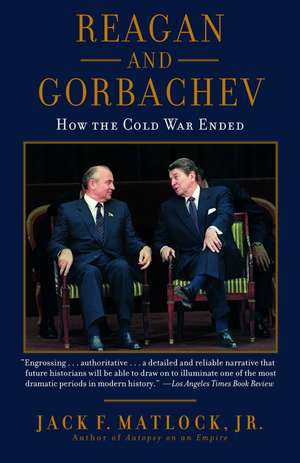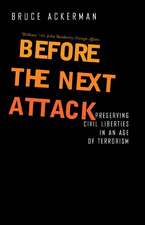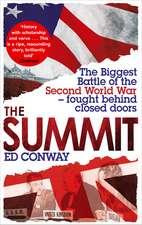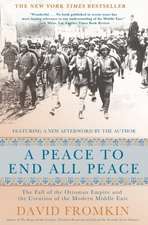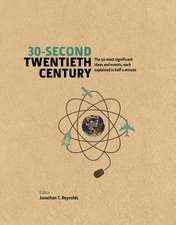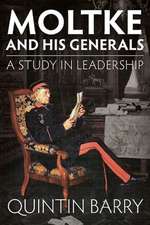Reagan and Gorbachev: How the Cold War Ended
Autor Jack F., Jr. Matlocken Limba Engleză Paperback – 31 oct 2005
Matlock details how, from the start of his term, Reagan privately pursued improved U.S.—U.S.S.R. relations, while rebuilding America’s military and fighting will in order to confront the Soviet Union while providing bargaining chips. When Gorbachev assumed leadership, however, Reagan and his advisers found a potential partner in the enterprise of peace. At first the two leaders sparred, agreeing on little. Gradually a form of trust emerged, with Gorbachev taking politically risky steps that bore long-term benefits, like the agreement to abolish intermediate-range nuclear missiles and the agreement to abolish intermediate-range nuclear missiles and the U.S.S.R.’s significant unilateral troop reductions in 1988.
Through his recollections and unparalleled access to the best and latest sources, Matlock describes Reagan’s and Gorbachev’s initial views of each other. We learn how the two prepared for their meetings; we discover that Reagan occasionally wrote to Gorbachev in his own hand, both to personalize the correspondence and to prevent nit-picking by hard-liners in his administration. We also see how the two men were pushed closer together by the unlikeliest characters (Senator Ted Kennedy and François Mitterrand among them) and by the two leaders’ remarkable foreign ministers, George Shultz and Eduard Shevardnadze.
The end of the Cold War is a key event in modern history, one that demanded bold individuals and decisive action. Both epic and intimate, Reagan and Gorbachev will be the standard reference, a work that is critical to our understanding of the present and the past.
From the Hardcover edition.
Preț: 146.09 lei
Nou
Puncte Express: 219
Preț estimativ în valută:
27.96€ • 29.40$ • 23.10£
27.96€ • 29.40$ • 23.10£
Carte disponibilă
Livrare economică 26 martie-09 aprilie
Preluare comenzi: 021 569.72.76
Specificații
ISBN-13: 9780812974898
ISBN-10: 0812974891
Pagini: 363
Ilustrații: 16 PP PHOTOS
Dimensiuni: 132 x 203 x 25 mm
Greutate: 0.43 kg
Editura: Random House Trade
ISBN-10: 0812974891
Pagini: 363
Ilustrații: 16 PP PHOTOS
Dimensiuni: 132 x 203 x 25 mm
Greutate: 0.43 kg
Editura: Random House Trade
Notă biografică
First posted to Moscow in 1961, career diplomat JACK F. MATLOCK, JR., was America’s man on the scene for most of the Cold War. A scholar of Russian history and culture, Matlock was President Reagan’s choice for the crucial post of ambassador to the Soviet Union. He is the author of Autopsy on an Empire: The American Ambassador’s Account of the Collapse of the Soviet Union. Matlock now divides his time between Princeton, New Jersey, and his wife’s farm in Booneville, Tennessee.
From the Hardcover edition.
From the Hardcover edition.
Extras
I
1981-82
REAGAN’S CHALLENGE
And I have to believe that our greatest goal must be peace.
—Ronald Reagan, June 6, 1981
I’ve always recognized that ultimately there’s got to be a settlement, a solution.
—Ronald Reagan, December 23, 1981
[A] Soviet leadership devoted to improving its people’s lives, rather than expanding its armed conquests, will find a sympathetic partner in the West.
—Ronald Reagan, May 9, 1982
Readers may suspect that the dates of the quotations set forth above are mistaken. After all, doesn’t everyone know that President Reagan spent his first term bashing the Soviet Union and showed an interest in serious negotiations only in his second term? Such is the myth that has developed of late.
The dates are correct. All of the remarks quoted were made during the first eighteen months of Reagan’s first administration. And they were not exceptional. These thoughts were present or clearly implied in virtually everything Reagan and his first secretary of state, Alexander Haig, said about relations with the Soviet Union from the outset of their terms in office.
Of course, these were not the only thoughts they expressed. Other statements, particularly when taken out of context, gave rise to the distorted impression that came to prevail in American and foreign opinion. Let us look carefully at what President Reagan said and how he said it.
During his first press conference as president, on January 29, 1981, Reagan stated that he was in favor of negotiating to achieve “an actual reduction in the numbers of nuclear weapons” on a basis that would be verifiable. He also declared that during any negotiation one had to take into account “other things that are going on,” and for that reason he believed in “linkage.”
A journalist asked what he thought of “the long-range intentions of the Soviet Union” and whether “the Kremlin is bent on world domination that might lead to a continuation of the cold war” or whether “under other circumstances détente is possible.” Addressing this convoluted question, Reagan replied that “so far détente has been a one-way street that the Soviet Union has used to pursue its own aims,” and that as far as Soviet intentions are concerned, their leaders have consistently said that “their goal must be the promotion of world revolution and a one-world Socialist or Communist state.”
Then he went on to add: “Now, as long as they do that and as long as they, at the same time, have openly and publicly declared that the only morality they recognize is what will further their cause, meaning they reserve unto themselves the right to commit any crime, to lie, to cheat, in order to attain that, and that is moral, not immoral, and we operate on a different set of standards, I think when you do business with them, even at a détente, you keep that in mind.”
Press and television reporters repeated his words about lying and cheating as if they were the heart of his approach.* Only an extraordinarily attentive reader would have grasped that Reagan referred to lying and cheating not as a personal moral defect of the Soviet leaders but as a feature of the philosophy they held. When asked about the remark subsequently, he denied that he was “castigating” the Soviet leaders “for lack of character,” and explained, “It’s just that they don’t think like we do.”
In fact, Reagan cited in his first press conference several themes that remained in the bedrock of his policy toward the Soviet Union throughout his eight years in office: arms reduction to equal levels, as deep as the Soviet Union would accept; verification of agreements; linkage of arms control negotiations with Soviet behavior, in particular Soviet use of arms outside its borders; and reciprocity, inasmuch as the Soviet Union had taken advantage of the relaxed atmosphere of the 1970s (“détente”) to its own advantage. Additional themes and many details were added to his “Soviet agenda” over the next three years, but Reagan never altered his commitment to the goals he enunciated on January 29, 1981.
* For example, the New York Times headlined its report on the news conference “President Reagan Assails Soviet Leaders for Reserving Right to ‘Commit Any Crime, to Lie and Cheat.’ ”
A Different Policy
president reagan was convinced that the strategy the United States had followed previously in dealing with the Soviet Union had not been effective. He expressed that judgment repeatedly during his campaigns for the presidency. Once he took office he was determined to do things differently.
The approach he described in his first press conference represented significant departures from President Jimmy Carter’s. In proposing an actual reduction in nuclear weapons, he was implicitly critical of the SALT II treaty that Carter had signed and the “Vladivostok agreement” concluded by President Gerald Ford, both of which would have placed limits on numbers of weapons without requiring a substantial reduction of existing arsenals. The condition that any agreement be verifiable was also intended to contrast Reagan’s approach with Carter’s, since Reagan and his supporters considered the verification provisions of SALT II inadequate.
Reagan’s endorsement of linkage was also the opposite of Carter’s policy, which had explicitly delinked arms control negotiations from other issues. Political reality had relinked the two, however, with the result that the Soviet invasion of Afghanistan was the final blow that prevented Senate ratification of SALT II.*
Reagan’s goal was to shift the U.S. strategy from reacting to challenges and limiting damage to a concerted effort to change Soviet behavior. His approach constituted a direct challenge to the Soviet leadership since it explicitly denied fundamental tenets of Communist ideology and required a Soviet about-face on many issues under negotiation. It was a challenge to think differently about Soviet security, the place of the Soviet Union in the world, and the nature of Soviet society. It altered both the substance of negotiations and the way the dialogue was conducted, but it did not require the Soviet Union to compromise its own security. Soviet claims to the contrary, it never threatened military action against the Soviet Union itself.
* When the SALT II treaty was before the U.S. Senate for ratification in 1979, I was a strong and vocal supporter of it. My support was not solely because, as a foreign service officer on active duty, I was obligated to support the president’s policy. I also judged that SALT II was the best that could be achieved at that time and that it could act as a brake on the arms race and open the door to significant reductions in the future. The Soviet invasion of Afghanistan in December 1979 changed my mind. It proved to me that the Soviet leaders were more interested in using force for geopolitical gain than in reducing arms, which ultimately would have made any arms limitation agreement a source of contention rather than a step toward ending the arms race. Furthermore, the reaction of the Senate and the American public demonstrated that separating the arms reduction process from other issues was not politically tenable in the United States.
During his first two years in office, Reagan explained his policies to the
public piecemeal and not always with coherence, but there was an inner consistency: to deter further aggressive behavior by the Soviet Union, to make sure the Soviet leaders could never have the illusion that they could win a war with the United States, and, having ensured against that, to prepare the United States for successful negotiations. He had no secret strategy, but described every element of his policy to the public.
Hindsight allows us to group Reagan’s early policies toward the Soviet Union in a few major tendencies, interrelated but distinct: telling the truth about the Soviet Union, restoring U.S. and allied strength, deterring aggression, and establishing reciprocity.
Setting the Record Straight
reagan was convinced that U.S. presidents had normally refrained from frank criticism of the Soviet Union when they tried to cooperate with it. During World War II he had seen how Hollywood, with encouragement from Washington, had created a picture of a benign “Uncle Joe” Stalin, a personally modest man dedicated to bringing about democracy and social justice to his backward country. In the interest of making Americans feel good about their Soviet ally, moviemakers of the day flagrantly distorted history, as in the film version of Joseph Davies’s Mission to Moscow, which portrays the innocent victims of Stalin’s purge trials as traitors, justly accused of treason.
Wouldn’t it have been better, Reagan asked, if Franklin Roosevelt had been more candid about the nature of the alliance with the Soviet Union? It really had nothing to do with whether the Soviet Union was a democracy or not, but whether cooperation was essential to defeat Hitler. It was, and it could be justified on that basis, without arousing extravagant expectations about the prospects for close postwar collaboration.
Later, other presidents had seemed to ignore the nature of the Soviet system whenever there was an effort to expand cooperation and control the arms race. Too often, he felt, this practice resulted in one-sided agreements that the Soviets exploited to their advantage. Even when balanced agreements were reached, the public was led to expect too much from them, and this could lead to overreaction if expectations were not met. Take the Soviet invasion of Afghanistan: didn’t Carter’s zeal to get the SALT II agreement ratified cause him to ignore the signs that the Soviets were preparing to enforce the Brezhnev Doctrine in Afghanistan? Carter said the Soviet invasion surprised him, but why, if he understood the Soviet system, should he have been surprised?
Far better, in Reagan’s view, to level with the American people and tell it like it really was. Only that would encourage realistic public expectations and the understanding that we were dealing with a power based on an ideology that permitted—indeed required—ethical standards quite different from those we professed and usually observed.
Nevertheless, he did not lead with his criticism of the Soviet Union, nor did he dwell on it in his prepared speeches early in his administration. Usually his comments were elicited by questions that he answered in the following spirit: “Yes, this is how they are and we need to keep that in mind when we deal with them. We don’t wish ill of them, but they’ve got to stop pushing other people around. It’s in their own interest to stop that, and if they do we can even cooperate.”
President Reagan did not himself offer a comprehensive statement regarding his policy toward the Soviet Union for more than a year. However, Secretary of State Alexander Haig spelled out U.S. policy in considerable detail, repeatedly emphasizing that it was not necessary for the Soviet Union to change internally “for East and West to manage their affairs in more constructive ways.” He stressed that the U.S. goal was “to demonstrate to the Soviet Union that aggressive and violent behavior will threaten Moscow’s own interests.” He added, “Only the U.S. has the power to persuade the Soviet leaders that improved relations with us serve Soviet as well as American interests.”
Both Reagan and Haig talked of the Soviet Union as a failed system facing increasing difficulties, but they felt that increasing Soviet reliance on military power abroad was both a danger to the peace and a source of weakness at home. Thus, in their view, if the United States could demonstrate to the Soviet leaders that they could not save their faltering system with military victories abroad and could not win an arms race with us, they would have no choice but to seek accommodation with the West in order to deal with their mounting problems at home. Haig put it most clearly in an address to the U.S. Chamber of Commerce in April 1982 when he remarked, “We must place our policy in the context of important changes that are taking place in the world and in the Soviet empire that may make Moscow more amenable to the virtues of restraint. The Soviet attempt to change the balance of power has produced a backlash of increasing international resistance. . . . As a consequence, the Soviet leaders may find it increasingly difficult to sustain the status quo at home while exporting a failed ideology abroad.”
Reagan was nearly a year and a half into his presidency when he delivered his first speech dealing in a comprehensive way with U.S.-Soviet relations. Pulling together thoughts that he had expressed piecemeal before, and repeating in his own words the ideas Haig had put forth, he announced: “I’m optimistic that we can build a more constructive relationship with the Soviet Union. . . . The Soviet empire is faltering because it is rigid; . . . in the end, this course will undermine the foundations of the Soviet system.”
Part of setting the record straight was to document and call attention to Soviet violations of previous agreements. Therefore, the White House ordered the U.S. intelligence community to study the record of Soviet compliance with agreements it had entered into with the United States or the international community. That study established what specialists already knew: The Soviet Union was continuing to violate several obligations it had undertaken. While some were relatively minor and technical, a few were important and blatant.
For example, most Soviet underground nuclear testing had resulted in venting more radioactive debris into the atmosphere than permitted by the Limited Test Ban Treaty, concluded in 1963 by President John Kennedy and General Secretary Nikita Khrushchev. U.S. protests had been met by denial rather than corrective action. An outbreak of anthrax near Sverdlovsk in 1979 seemed caused by a leak from a biological warfare facility—banned by a 1972 treaty—but the Soviet government claimed implausibly that it was caused by consumption of infected meat. Overhead pictures revealed that the Soviet Union was constructing a giant phased-array radar station not far from Krasnoyarsk in Siberia. Their intent was obvious: to cover a gap in their early-warning radar system. The 1972 ABM Treaty with the United States specified that such stations could be built only near a country’s borders and have an outward orientation. The station near Krasnoyarsk was thousands of miles inland and was oriented to cover much of northern Siberia. Nevertheless, the Soviets claimed that it was only for “deep space tracking” and therefore not relevant to obligations under the ABM Treaty.
These were specific actions that unquestionably violated legal obligations freely undertaken by the Soviet Union. Not all agreements, however, had been legally binding treaties. A number of declarations of intent or principle had been issued over the years, documents such as the Universal Declaration of Human Rights, the U.S.-Soviet Declaration of Principles of 1972, and, in 1975, the Helsinki Final Act. These were political rather than legal commitments, and Soviet leaders generally ignored them unless they contained provisions that could be used against the West. In the case of the Helsinki accord, which obligated the signatories to respect and enforce an extensive list of human rights, there had not been the slightest effort to bring Soviet practices in harmony with the principles established. Soviet officials often refused even to discuss violations of these principles, on grounds that they were purely matters of internal jurisdiction.
The general conclusion drawn by President Reagan and his secretaries of state was not that treaties with the Soviet Union were worthless. They recognized that the Soviet Union had complied with many of the provisions of the legally binding treaties. Soviet leaders had fulfilled treaty obligations whenever they considered it more in their interest to comply than to violate. However, the violations demonstrated the importance of negotiating a treaty with great care and ensuring that the United States could determine what was going on. Experience with past treaties suggested that it was unwise to sweep violations under the rug in the hope that the Soviet authorities would quietly correct the situation and do better next time. So long as their tendency was to deny that the violation had occurred, this would not work.
As for the agreements involving political obligations, the conclusion was different. While it was important to keep calling attention to violations in the hope that eventually this might have some effect, such commitments up to then had proven hollow. There was no need to negotiate any more of this type until there was a better record of compliance with those already signed.
From the Hardcover edition.
1981-82
REAGAN’S CHALLENGE
And I have to believe that our greatest goal must be peace.
—Ronald Reagan, June 6, 1981
I’ve always recognized that ultimately there’s got to be a settlement, a solution.
—Ronald Reagan, December 23, 1981
[A] Soviet leadership devoted to improving its people’s lives, rather than expanding its armed conquests, will find a sympathetic partner in the West.
—Ronald Reagan, May 9, 1982
Readers may suspect that the dates of the quotations set forth above are mistaken. After all, doesn’t everyone know that President Reagan spent his first term bashing the Soviet Union and showed an interest in serious negotiations only in his second term? Such is the myth that has developed of late.
The dates are correct. All of the remarks quoted were made during the first eighteen months of Reagan’s first administration. And they were not exceptional. These thoughts were present or clearly implied in virtually everything Reagan and his first secretary of state, Alexander Haig, said about relations with the Soviet Union from the outset of their terms in office.
Of course, these were not the only thoughts they expressed. Other statements, particularly when taken out of context, gave rise to the distorted impression that came to prevail in American and foreign opinion. Let us look carefully at what President Reagan said and how he said it.
During his first press conference as president, on January 29, 1981, Reagan stated that he was in favor of negotiating to achieve “an actual reduction in the numbers of nuclear weapons” on a basis that would be verifiable. He also declared that during any negotiation one had to take into account “other things that are going on,” and for that reason he believed in “linkage.”
A journalist asked what he thought of “the long-range intentions of the Soviet Union” and whether “the Kremlin is bent on world domination that might lead to a continuation of the cold war” or whether “under other circumstances détente is possible.” Addressing this convoluted question, Reagan replied that “so far détente has been a one-way street that the Soviet Union has used to pursue its own aims,” and that as far as Soviet intentions are concerned, their leaders have consistently said that “their goal must be the promotion of world revolution and a one-world Socialist or Communist state.”
Then he went on to add: “Now, as long as they do that and as long as they, at the same time, have openly and publicly declared that the only morality they recognize is what will further their cause, meaning they reserve unto themselves the right to commit any crime, to lie, to cheat, in order to attain that, and that is moral, not immoral, and we operate on a different set of standards, I think when you do business with them, even at a détente, you keep that in mind.”
Press and television reporters repeated his words about lying and cheating as if they were the heart of his approach.* Only an extraordinarily attentive reader would have grasped that Reagan referred to lying and cheating not as a personal moral defect of the Soviet leaders but as a feature of the philosophy they held. When asked about the remark subsequently, he denied that he was “castigating” the Soviet leaders “for lack of character,” and explained, “It’s just that they don’t think like we do.”
In fact, Reagan cited in his first press conference several themes that remained in the bedrock of his policy toward the Soviet Union throughout his eight years in office: arms reduction to equal levels, as deep as the Soviet Union would accept; verification of agreements; linkage of arms control negotiations with Soviet behavior, in particular Soviet use of arms outside its borders; and reciprocity, inasmuch as the Soviet Union had taken advantage of the relaxed atmosphere of the 1970s (“détente”) to its own advantage. Additional themes and many details were added to his “Soviet agenda” over the next three years, but Reagan never altered his commitment to the goals he enunciated on January 29, 1981.
* For example, the New York Times headlined its report on the news conference “President Reagan Assails Soviet Leaders for Reserving Right to ‘Commit Any Crime, to Lie and Cheat.’ ”
A Different Policy
president reagan was convinced that the strategy the United States had followed previously in dealing with the Soviet Union had not been effective. He expressed that judgment repeatedly during his campaigns for the presidency. Once he took office he was determined to do things differently.
The approach he described in his first press conference represented significant departures from President Jimmy Carter’s. In proposing an actual reduction in nuclear weapons, he was implicitly critical of the SALT II treaty that Carter had signed and the “Vladivostok agreement” concluded by President Gerald Ford, both of which would have placed limits on numbers of weapons without requiring a substantial reduction of existing arsenals. The condition that any agreement be verifiable was also intended to contrast Reagan’s approach with Carter’s, since Reagan and his supporters considered the verification provisions of SALT II inadequate.
Reagan’s endorsement of linkage was also the opposite of Carter’s policy, which had explicitly delinked arms control negotiations from other issues. Political reality had relinked the two, however, with the result that the Soviet invasion of Afghanistan was the final blow that prevented Senate ratification of SALT II.*
Reagan’s goal was to shift the U.S. strategy from reacting to challenges and limiting damage to a concerted effort to change Soviet behavior. His approach constituted a direct challenge to the Soviet leadership since it explicitly denied fundamental tenets of Communist ideology and required a Soviet about-face on many issues under negotiation. It was a challenge to think differently about Soviet security, the place of the Soviet Union in the world, and the nature of Soviet society. It altered both the substance of negotiations and the way the dialogue was conducted, but it did not require the Soviet Union to compromise its own security. Soviet claims to the contrary, it never threatened military action against the Soviet Union itself.
* When the SALT II treaty was before the U.S. Senate for ratification in 1979, I was a strong and vocal supporter of it. My support was not solely because, as a foreign service officer on active duty, I was obligated to support the president’s policy. I also judged that SALT II was the best that could be achieved at that time and that it could act as a brake on the arms race and open the door to significant reductions in the future. The Soviet invasion of Afghanistan in December 1979 changed my mind. It proved to me that the Soviet leaders were more interested in using force for geopolitical gain than in reducing arms, which ultimately would have made any arms limitation agreement a source of contention rather than a step toward ending the arms race. Furthermore, the reaction of the Senate and the American public demonstrated that separating the arms reduction process from other issues was not politically tenable in the United States.
During his first two years in office, Reagan explained his policies to the
public piecemeal and not always with coherence, but there was an inner consistency: to deter further aggressive behavior by the Soviet Union, to make sure the Soviet leaders could never have the illusion that they could win a war with the United States, and, having ensured against that, to prepare the United States for successful negotiations. He had no secret strategy, but described every element of his policy to the public.
Hindsight allows us to group Reagan’s early policies toward the Soviet Union in a few major tendencies, interrelated but distinct: telling the truth about the Soviet Union, restoring U.S. and allied strength, deterring aggression, and establishing reciprocity.
Setting the Record Straight
reagan was convinced that U.S. presidents had normally refrained from frank criticism of the Soviet Union when they tried to cooperate with it. During World War II he had seen how Hollywood, with encouragement from Washington, had created a picture of a benign “Uncle Joe” Stalin, a personally modest man dedicated to bringing about democracy and social justice to his backward country. In the interest of making Americans feel good about their Soviet ally, moviemakers of the day flagrantly distorted history, as in the film version of Joseph Davies’s Mission to Moscow, which portrays the innocent victims of Stalin’s purge trials as traitors, justly accused of treason.
Wouldn’t it have been better, Reagan asked, if Franklin Roosevelt had been more candid about the nature of the alliance with the Soviet Union? It really had nothing to do with whether the Soviet Union was a democracy or not, but whether cooperation was essential to defeat Hitler. It was, and it could be justified on that basis, without arousing extravagant expectations about the prospects for close postwar collaboration.
Later, other presidents had seemed to ignore the nature of the Soviet system whenever there was an effort to expand cooperation and control the arms race. Too often, he felt, this practice resulted in one-sided agreements that the Soviets exploited to their advantage. Even when balanced agreements were reached, the public was led to expect too much from them, and this could lead to overreaction if expectations were not met. Take the Soviet invasion of Afghanistan: didn’t Carter’s zeal to get the SALT II agreement ratified cause him to ignore the signs that the Soviets were preparing to enforce the Brezhnev Doctrine in Afghanistan? Carter said the Soviet invasion surprised him, but why, if he understood the Soviet system, should he have been surprised?
Far better, in Reagan’s view, to level with the American people and tell it like it really was. Only that would encourage realistic public expectations and the understanding that we were dealing with a power based on an ideology that permitted—indeed required—ethical standards quite different from those we professed and usually observed.
Nevertheless, he did not lead with his criticism of the Soviet Union, nor did he dwell on it in his prepared speeches early in his administration. Usually his comments were elicited by questions that he answered in the following spirit: “Yes, this is how they are and we need to keep that in mind when we deal with them. We don’t wish ill of them, but they’ve got to stop pushing other people around. It’s in their own interest to stop that, and if they do we can even cooperate.”
President Reagan did not himself offer a comprehensive statement regarding his policy toward the Soviet Union for more than a year. However, Secretary of State Alexander Haig spelled out U.S. policy in considerable detail, repeatedly emphasizing that it was not necessary for the Soviet Union to change internally “for East and West to manage their affairs in more constructive ways.” He stressed that the U.S. goal was “to demonstrate to the Soviet Union that aggressive and violent behavior will threaten Moscow’s own interests.” He added, “Only the U.S. has the power to persuade the Soviet leaders that improved relations with us serve Soviet as well as American interests.”
Both Reagan and Haig talked of the Soviet Union as a failed system facing increasing difficulties, but they felt that increasing Soviet reliance on military power abroad was both a danger to the peace and a source of weakness at home. Thus, in their view, if the United States could demonstrate to the Soviet leaders that they could not save their faltering system with military victories abroad and could not win an arms race with us, they would have no choice but to seek accommodation with the West in order to deal with their mounting problems at home. Haig put it most clearly in an address to the U.S. Chamber of Commerce in April 1982 when he remarked, “We must place our policy in the context of important changes that are taking place in the world and in the Soviet empire that may make Moscow more amenable to the virtues of restraint. The Soviet attempt to change the balance of power has produced a backlash of increasing international resistance. . . . As a consequence, the Soviet leaders may find it increasingly difficult to sustain the status quo at home while exporting a failed ideology abroad.”
Reagan was nearly a year and a half into his presidency when he delivered his first speech dealing in a comprehensive way with U.S.-Soviet relations. Pulling together thoughts that he had expressed piecemeal before, and repeating in his own words the ideas Haig had put forth, he announced: “I’m optimistic that we can build a more constructive relationship with the Soviet Union. . . . The Soviet empire is faltering because it is rigid; . . . in the end, this course will undermine the foundations of the Soviet system.”
Part of setting the record straight was to document and call attention to Soviet violations of previous agreements. Therefore, the White House ordered the U.S. intelligence community to study the record of Soviet compliance with agreements it had entered into with the United States or the international community. That study established what specialists already knew: The Soviet Union was continuing to violate several obligations it had undertaken. While some were relatively minor and technical, a few were important and blatant.
For example, most Soviet underground nuclear testing had resulted in venting more radioactive debris into the atmosphere than permitted by the Limited Test Ban Treaty, concluded in 1963 by President John Kennedy and General Secretary Nikita Khrushchev. U.S. protests had been met by denial rather than corrective action. An outbreak of anthrax near Sverdlovsk in 1979 seemed caused by a leak from a biological warfare facility—banned by a 1972 treaty—but the Soviet government claimed implausibly that it was caused by consumption of infected meat. Overhead pictures revealed that the Soviet Union was constructing a giant phased-array radar station not far from Krasnoyarsk in Siberia. Their intent was obvious: to cover a gap in their early-warning radar system. The 1972 ABM Treaty with the United States specified that such stations could be built only near a country’s borders and have an outward orientation. The station near Krasnoyarsk was thousands of miles inland and was oriented to cover much of northern Siberia. Nevertheless, the Soviets claimed that it was only for “deep space tracking” and therefore not relevant to obligations under the ABM Treaty.
These were specific actions that unquestionably violated legal obligations freely undertaken by the Soviet Union. Not all agreements, however, had been legally binding treaties. A number of declarations of intent or principle had been issued over the years, documents such as the Universal Declaration of Human Rights, the U.S.-Soviet Declaration of Principles of 1972, and, in 1975, the Helsinki Final Act. These were political rather than legal commitments, and Soviet leaders generally ignored them unless they contained provisions that could be used against the West. In the case of the Helsinki accord, which obligated the signatories to respect and enforce an extensive list of human rights, there had not been the slightest effort to bring Soviet practices in harmony with the principles established. Soviet officials often refused even to discuss violations of these principles, on grounds that they were purely matters of internal jurisdiction.
The general conclusion drawn by President Reagan and his secretaries of state was not that treaties with the Soviet Union were worthless. They recognized that the Soviet Union had complied with many of the provisions of the legally binding treaties. Soviet leaders had fulfilled treaty obligations whenever they considered it more in their interest to comply than to violate. However, the violations demonstrated the importance of negotiating a treaty with great care and ensuring that the United States could determine what was going on. Experience with past treaties suggested that it was unwise to sweep violations under the rug in the hope that the Soviet authorities would quietly correct the situation and do better next time. So long as their tendency was to deny that the violation had occurred, this would not work.
As for the agreements involving political obligations, the conclusion was different. While it was important to keep calling attention to violations in the hope that eventually this might have some effect, such commitments up to then had proven hollow. There was no need to negotiate any more of this type until there was a better record of compliance with those already signed.
From the Hardcover edition.
Recenzii
Praise for Autopsy on an Empire
“A superb analysis of the achievements and problems of the Soviet system and a fascinating account of the people and events that brought its collapse . . . Matlock writes with the authority of long years of service in Moscow, and at the State Department and the National Security Council. His close-up view of the most important events of our century is the unique product of careful scholarship and an extraordinary diplomatic career.”
–HERBERT J. ELLISON, professor of Russian history, Henry M. Jackson School of International Studies, University of Washington
“No person is better equipped to describe the extraordinary change from the Soviet Union into Russia than Ambassador Matlock. His background in Russian history, language, culture, literature, and politics makes him one of the world’s outstanding authorities on the question. . . . [Matlock] knows practically all of the people about whom he is writing and conveys their character, prejudices, strengths, and shortcomings in vivid colors.”
–MAX M. KAMPELMAN, former counselor of the Department of State and U.S. nuclear arms control negotiator
“No other American had the opportunity to observe the Soviet government’s collapse at such close range. Thanks to Ambassador Matlock’s excellent contacts and mature judgment, his book represents a unique record of this historic event.”
–RICHARD PIPES, Frank Baird, Jr., Professor of History Emeritus, Harvard University
From the Hardcover edition.
“A superb analysis of the achievements and problems of the Soviet system and a fascinating account of the people and events that brought its collapse . . . Matlock writes with the authority of long years of service in Moscow, and at the State Department and the National Security Council. His close-up view of the most important events of our century is the unique product of careful scholarship and an extraordinary diplomatic career.”
–HERBERT J. ELLISON, professor of Russian history, Henry M. Jackson School of International Studies, University of Washington
“No person is better equipped to describe the extraordinary change from the Soviet Union into Russia than Ambassador Matlock. His background in Russian history, language, culture, literature, and politics makes him one of the world’s outstanding authorities on the question. . . . [Matlock] knows practically all of the people about whom he is writing and conveys their character, prejudices, strengths, and shortcomings in vivid colors.”
–MAX M. KAMPELMAN, former counselor of the Department of State and U.S. nuclear arms control negotiator
“No other American had the opportunity to observe the Soviet government’s collapse at such close range. Thanks to Ambassador Matlock’s excellent contacts and mature judgment, his book represents a unique record of this historic event.”
–RICHARD PIPES, Frank Baird, Jr., Professor of History Emeritus, Harvard University
From the Hardcover edition.
